Management Accounting Report: Improving Financial Performance
VerifiedAdded on 2019/12/18
|23
|4722
|275
Report
AI Summary
This report delves into the application of management accounting principles within a small-scale hospitality business. It begins by justifying the need for management accounting systems, emphasizing their role in providing critical financial and operational insights. The report then explores various management accounting tools, including cost accounting, inventory management, job costing, and price optimization, highlighting their benefits in improving financial efficiency and decision-making. A significant portion of the report is dedicated to cost-volume-profit analysis and budgeting, demonstrating how these techniques can be used to track costs, forecast future performance, and make informed decisions about pricing and resource allocation. The report also presents a detailed analysis of standard costing and its role in controlling business performance, providing a comprehensive overview of management accounting practices for enhancing financial performance.
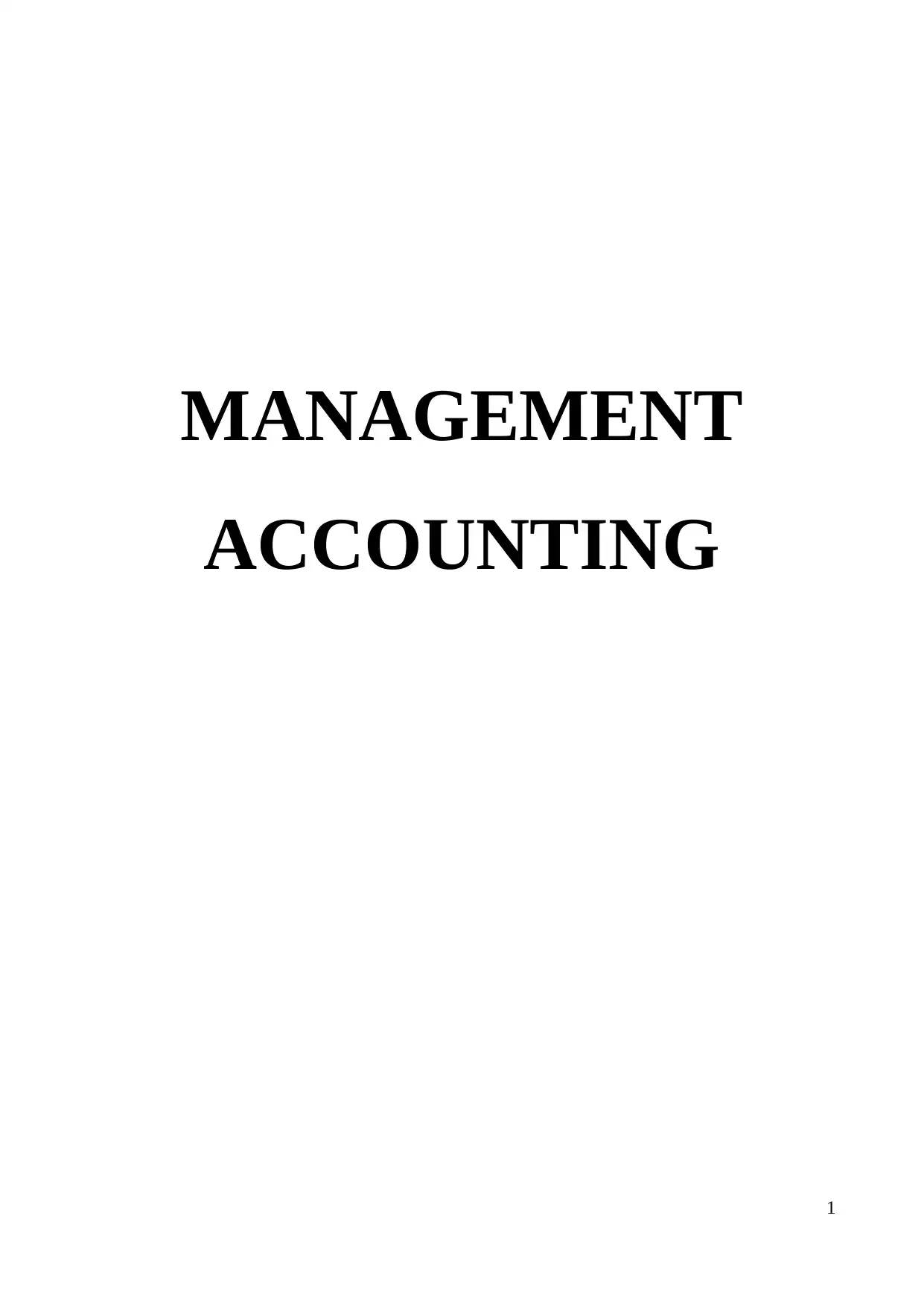
MANAGEMENT
ACCOUNTING
1
ACCOUNTING
1
Paraphrase This Document
Need a fresh take? Get an instant paraphrase of this document with our AI Paraphraser
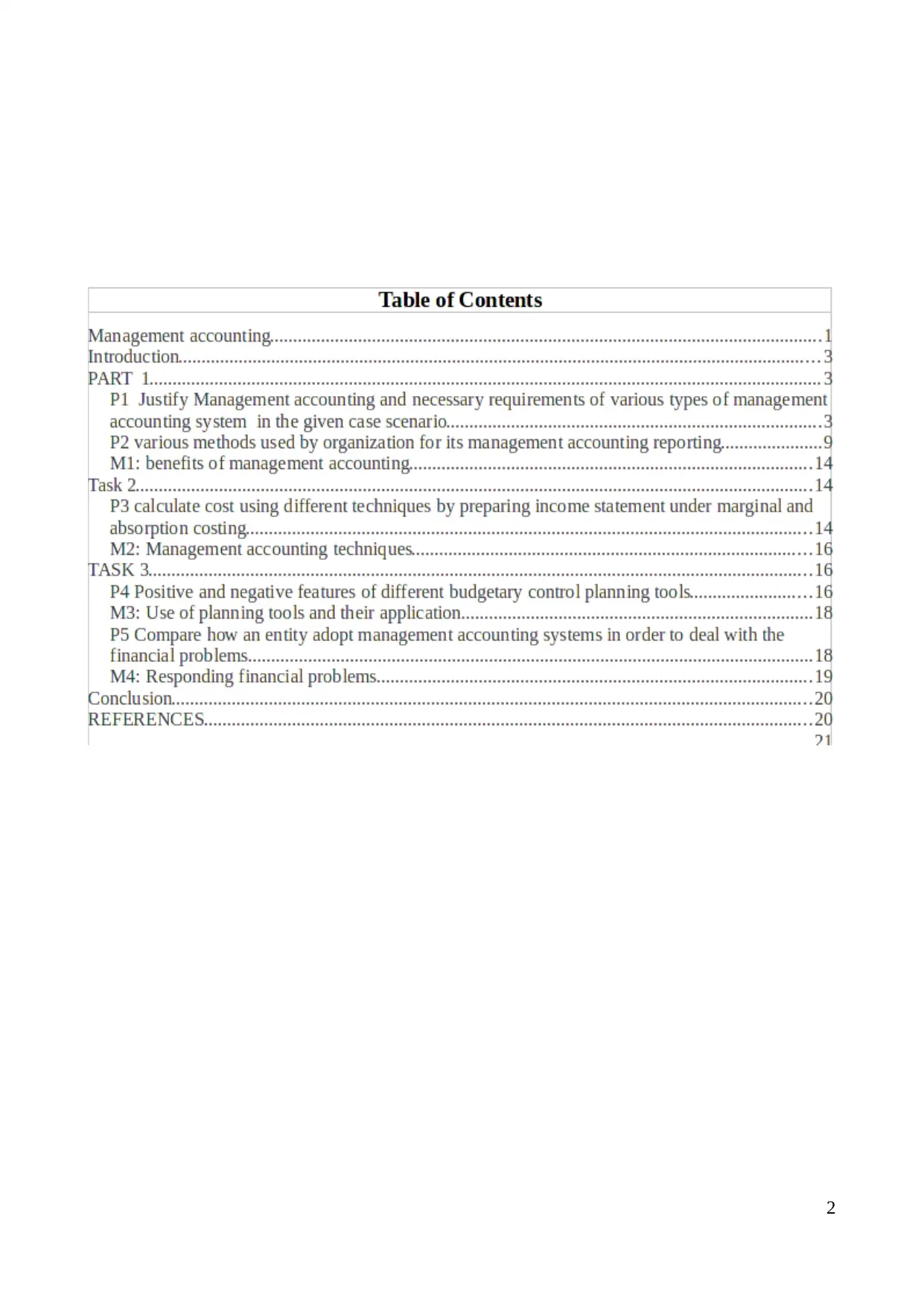
2
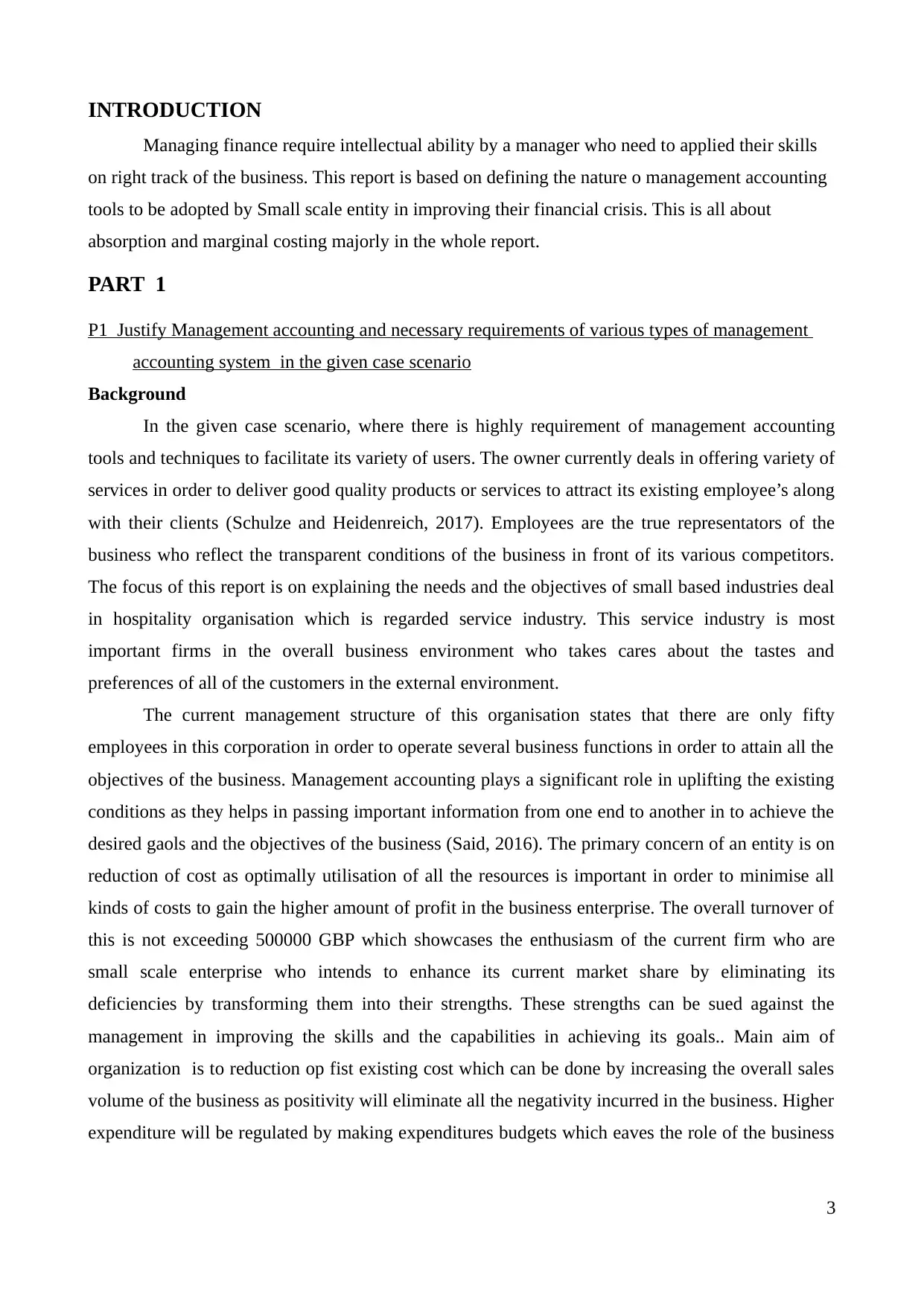
INTRODUCTION
Managing finance require intellectual ability by a manager who need to applied their skills
on right track of the business. This report is based on defining the nature o management accounting
tools to be adopted by Small scale entity in improving their financial crisis. This is all about
absorption and marginal costing majorly in the whole report.
PART 1
P1 Justify Management accounting and necessary requirements of various types of management
accounting system in the given case scenario
Background
In the given case scenario, where there is highly requirement of management accounting
tools and techniques to facilitate its variety of users. The owner currently deals in offering variety of
services in order to deliver good quality products or services to attract its existing employee’s along
with their clients (Schulze and Heidenreich, 2017). Employees are the true representators of the
business who reflect the transparent conditions of the business in front of its various competitors.
The focus of this report is on explaining the needs and the objectives of small based industries deal
in hospitality organisation which is regarded service industry. This service industry is most
important firms in the overall business environment who takes cares about the tastes and
preferences of all of the customers in the external environment.
The current management structure of this organisation states that there are only fifty
employees in this corporation in order to operate several business functions in order to attain all the
objectives of the business. Management accounting plays a significant role in uplifting the existing
conditions as they helps in passing important information from one end to another in to achieve the
desired gaols and the objectives of the business (Said, 2016). The primary concern of an entity is on
reduction of cost as optimally utilisation of all the resources is important in order to minimise all
kinds of costs to gain the higher amount of profit in the business enterprise. The overall turnover of
this is not exceeding 500000 GBP which showcases the enthusiasm of the current firm who are
small scale enterprise who intends to enhance its current market share by eliminating its
deficiencies by transforming them into their strengths. These strengths can be sued against the
management in improving the skills and the capabilities in achieving its goals.. Main aim of
organization is to reduction op fist existing cost which can be done by increasing the overall sales
volume of the business as positivity will eliminate all the negativity incurred in the business. Higher
expenditure will be regulated by making expenditures budgets which eaves the role of the business
3
Managing finance require intellectual ability by a manager who need to applied their skills
on right track of the business. This report is based on defining the nature o management accounting
tools to be adopted by Small scale entity in improving their financial crisis. This is all about
absorption and marginal costing majorly in the whole report.
PART 1
P1 Justify Management accounting and necessary requirements of various types of management
accounting system in the given case scenario
Background
In the given case scenario, where there is highly requirement of management accounting
tools and techniques to facilitate its variety of users. The owner currently deals in offering variety of
services in order to deliver good quality products or services to attract its existing employee’s along
with their clients (Schulze and Heidenreich, 2017). Employees are the true representators of the
business who reflect the transparent conditions of the business in front of its various competitors.
The focus of this report is on explaining the needs and the objectives of small based industries deal
in hospitality organisation which is regarded service industry. This service industry is most
important firms in the overall business environment who takes cares about the tastes and
preferences of all of the customers in the external environment.
The current management structure of this organisation states that there are only fifty
employees in this corporation in order to operate several business functions in order to attain all the
objectives of the business. Management accounting plays a significant role in uplifting the existing
conditions as they helps in passing important information from one end to another in to achieve the
desired gaols and the objectives of the business (Said, 2016). The primary concern of an entity is on
reduction of cost as optimally utilisation of all the resources is important in order to minimise all
kinds of costs to gain the higher amount of profit in the business enterprise. The overall turnover of
this is not exceeding 500000 GBP which showcases the enthusiasm of the current firm who are
small scale enterprise who intends to enhance its current market share by eliminating its
deficiencies by transforming them into their strengths. These strengths can be sued against the
management in improving the skills and the capabilities in achieving its goals.. Main aim of
organization is to reduction op fist existing cost which can be done by increasing the overall sales
volume of the business as positivity will eliminate all the negativity incurred in the business. Higher
expenditure will be regulated by making expenditures budgets which eaves the role of the business
3
⊘ This is a preview!⊘
Do you want full access?
Subscribe today to unlock all pages.

Trusted by 1+ million students worldwide
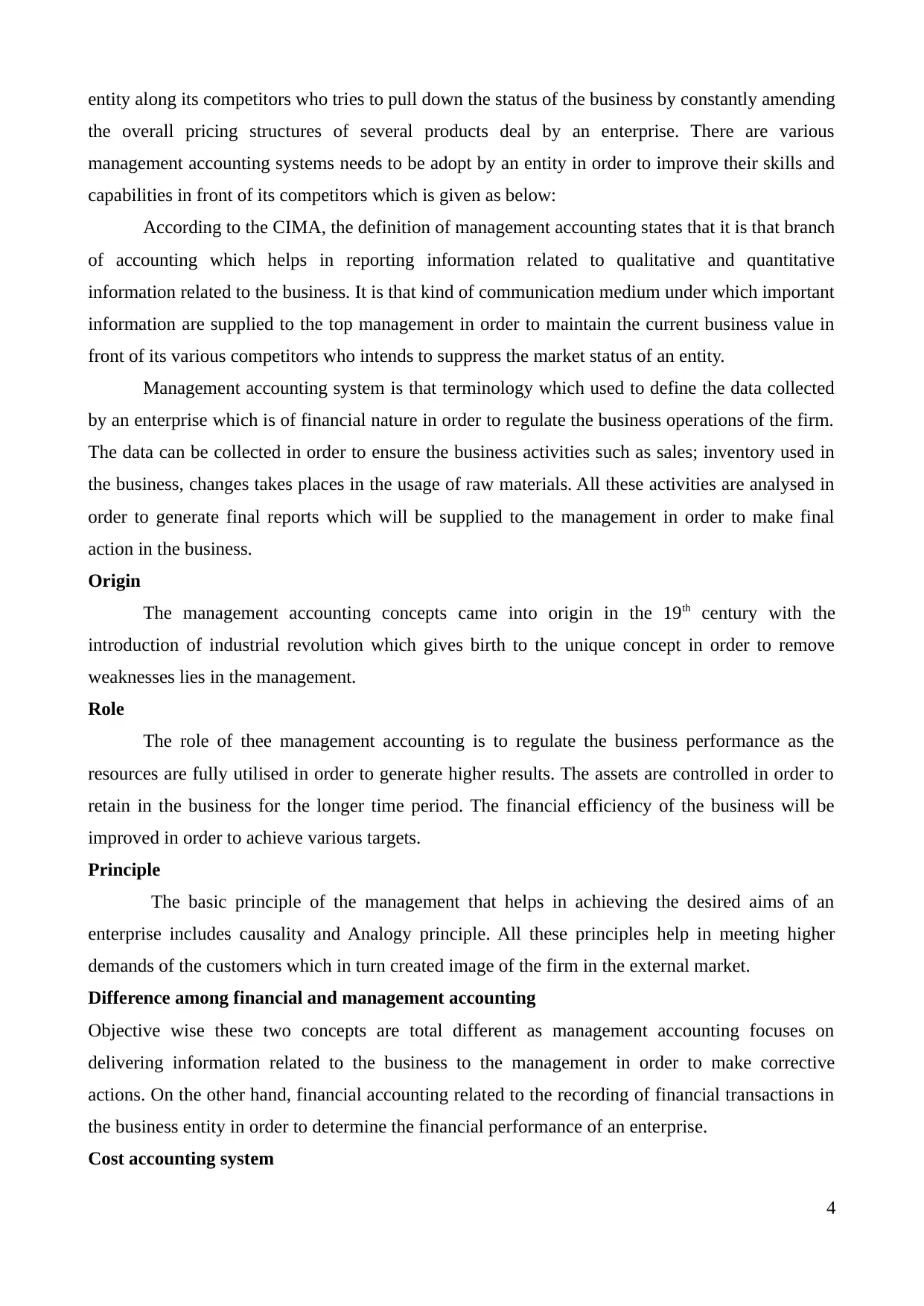
entity along its competitors who tries to pull down the status of the business by constantly amending
the overall pricing structures of several products deal by an enterprise. There are various
management accounting systems needs to be adopt by an entity in order to improve their skills and
capabilities in front of its competitors which is given as below:
According to the CIMA, the definition of management accounting states that it is that branch
of accounting which helps in reporting information related to qualitative and quantitative
information related to the business. It is that kind of communication medium under which important
information are supplied to the top management in order to maintain the current business value in
front of its various competitors who intends to suppress the market status of an entity.
Management accounting system is that terminology which used to define the data collected
by an enterprise which is of financial nature in order to regulate the business operations of the firm.
The data can be collected in order to ensure the business activities such as sales; inventory used in
the business, changes takes places in the usage of raw materials. All these activities are analysed in
order to generate final reports which will be supplied to the management in order to make final
action in the business.
Origin
The management accounting concepts came into origin in the 19th century with the
introduction of industrial revolution which gives birth to the unique concept in order to remove
weaknesses lies in the management.
Role
The role of thee management accounting is to regulate the business performance as the
resources are fully utilised in order to generate higher results. The assets are controlled in order to
retain in the business for the longer time period. The financial efficiency of the business will be
improved in order to achieve various targets.
Principle
The basic principle of the management that helps in achieving the desired aims of an
enterprise includes causality and Analogy principle. All these principles help in meeting higher
demands of the customers which in turn created image of the firm in the external market.
Difference among financial and management accounting
Objective wise these two concepts are total different as management accounting focuses on
delivering information related to the business to the management in order to make corrective
actions. On the other hand, financial accounting related to the recording of financial transactions in
the business entity in order to determine the financial performance of an enterprise.
Cost accounting system
4
the overall pricing structures of several products deal by an enterprise. There are various
management accounting systems needs to be adopt by an entity in order to improve their skills and
capabilities in front of its competitors which is given as below:
According to the CIMA, the definition of management accounting states that it is that branch
of accounting which helps in reporting information related to qualitative and quantitative
information related to the business. It is that kind of communication medium under which important
information are supplied to the top management in order to maintain the current business value in
front of its various competitors who intends to suppress the market status of an entity.
Management accounting system is that terminology which used to define the data collected
by an enterprise which is of financial nature in order to regulate the business operations of the firm.
The data can be collected in order to ensure the business activities such as sales; inventory used in
the business, changes takes places in the usage of raw materials. All these activities are analysed in
order to generate final reports which will be supplied to the management in order to make final
action in the business.
Origin
The management accounting concepts came into origin in the 19th century with the
introduction of industrial revolution which gives birth to the unique concept in order to remove
weaknesses lies in the management.
Role
The role of thee management accounting is to regulate the business performance as the
resources are fully utilised in order to generate higher results. The assets are controlled in order to
retain in the business for the longer time period. The financial efficiency of the business will be
improved in order to achieve various targets.
Principle
The basic principle of the management that helps in achieving the desired aims of an
enterprise includes causality and Analogy principle. All these principles help in meeting higher
demands of the customers which in turn created image of the firm in the external market.
Difference among financial and management accounting
Objective wise these two concepts are total different as management accounting focuses on
delivering information related to the business to the management in order to make corrective
actions. On the other hand, financial accounting related to the recording of financial transactions in
the business entity in order to determine the financial performance of an enterprise.
Cost accounting system
4
Paraphrase This Document
Need a fresh take? Get an instant paraphrase of this document with our AI Paraphraser
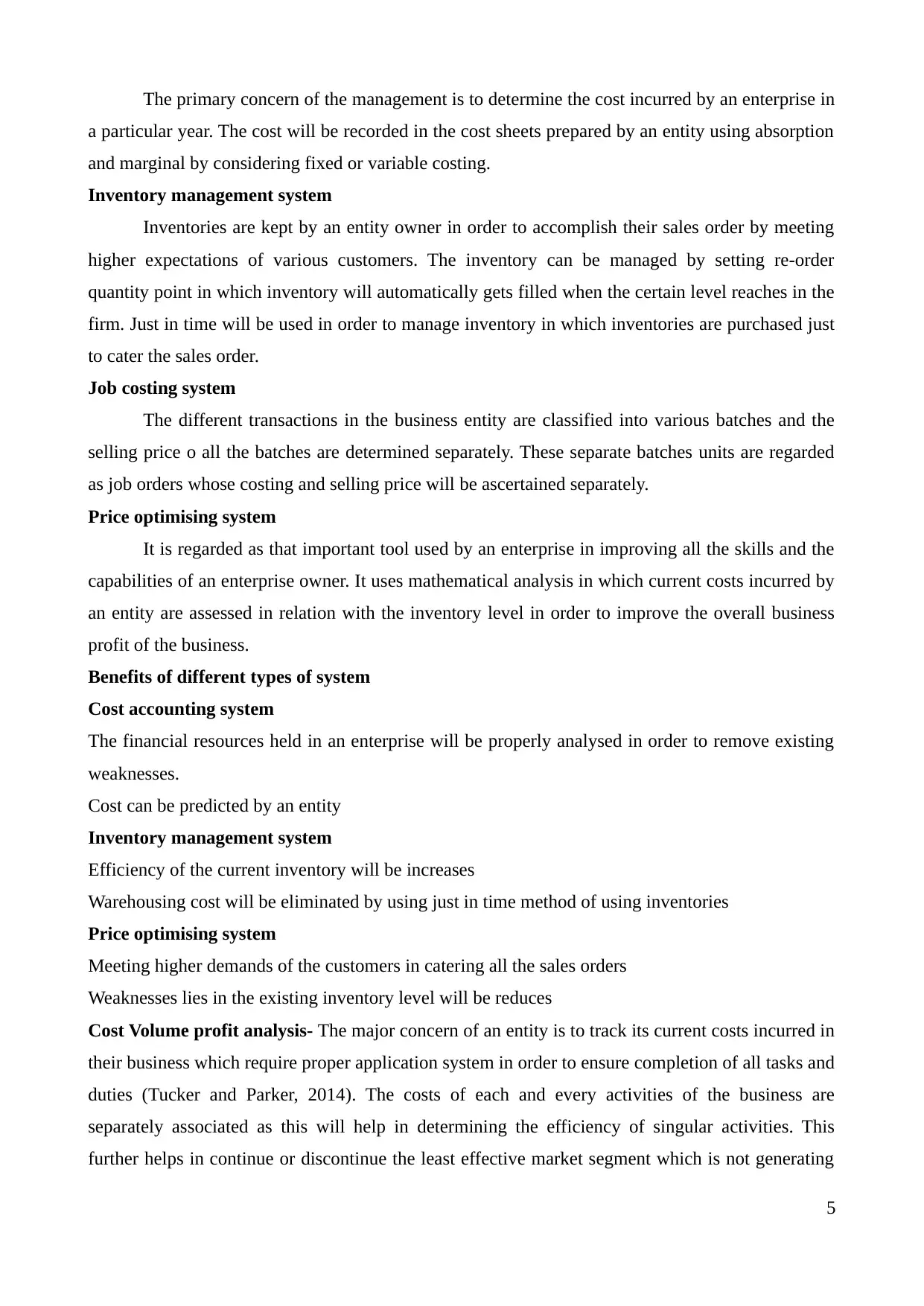
The primary concern of the management is to determine the cost incurred by an enterprise in
a particular year. The cost will be recorded in the cost sheets prepared by an entity using absorption
and marginal by considering fixed or variable costing.
Inventory management system
Inventories are kept by an entity owner in order to accomplish their sales order by meeting
higher expectations of various customers. The inventory can be managed by setting re-order
quantity point in which inventory will automatically gets filled when the certain level reaches in the
firm. Just in time will be used in order to manage inventory in which inventories are purchased just
to cater the sales order.
Job costing system
The different transactions in the business entity are classified into various batches and the
selling price o all the batches are determined separately. These separate batches units are regarded
as job orders whose costing and selling price will be ascertained separately.
Price optimising system
It is regarded as that important tool used by an enterprise in improving all the skills and the
capabilities of an enterprise owner. It uses mathematical analysis in which current costs incurred by
an entity are assessed in relation with the inventory level in order to improve the overall business
profit of the business.
Benefits of different types of system
Cost accounting system
The financial resources held in an enterprise will be properly analysed in order to remove existing
weaknesses.
Cost can be predicted by an entity
Inventory management system
Efficiency of the current inventory will be increases
Warehousing cost will be eliminated by using just in time method of using inventories
Price optimising system
Meeting higher demands of the customers in catering all the sales orders
Weaknesses lies in the existing inventory level will be reduces
Cost Volume profit analysis- The major concern of an entity is to track its current costs incurred in
their business which require proper application system in order to ensure completion of all tasks and
duties (Tucker and Parker, 2014). The costs of each and every activities of the business are
separately associated as this will help in determining the efficiency of singular activities. This
further helps in continue or discontinue the least effective market segment which is not generating
5
a particular year. The cost will be recorded in the cost sheets prepared by an entity using absorption
and marginal by considering fixed or variable costing.
Inventory management system
Inventories are kept by an entity owner in order to accomplish their sales order by meeting
higher expectations of various customers. The inventory can be managed by setting re-order
quantity point in which inventory will automatically gets filled when the certain level reaches in the
firm. Just in time will be used in order to manage inventory in which inventories are purchased just
to cater the sales order.
Job costing system
The different transactions in the business entity are classified into various batches and the
selling price o all the batches are determined separately. These separate batches units are regarded
as job orders whose costing and selling price will be ascertained separately.
Price optimising system
It is regarded as that important tool used by an enterprise in improving all the skills and the
capabilities of an enterprise owner. It uses mathematical analysis in which current costs incurred by
an entity are assessed in relation with the inventory level in order to improve the overall business
profit of the business.
Benefits of different types of system
Cost accounting system
The financial resources held in an enterprise will be properly analysed in order to remove existing
weaknesses.
Cost can be predicted by an entity
Inventory management system
Efficiency of the current inventory will be increases
Warehousing cost will be eliminated by using just in time method of using inventories
Price optimising system
Meeting higher demands of the customers in catering all the sales orders
Weaknesses lies in the existing inventory level will be reduces
Cost Volume profit analysis- The major concern of an entity is to track its current costs incurred in
their business which require proper application system in order to ensure completion of all tasks and
duties (Tucker and Parker, 2014). The costs of each and every activities of the business are
separately associated as this will help in determining the efficiency of singular activities. This
further helps in continue or discontinue the least effective market segment which is not generating
5
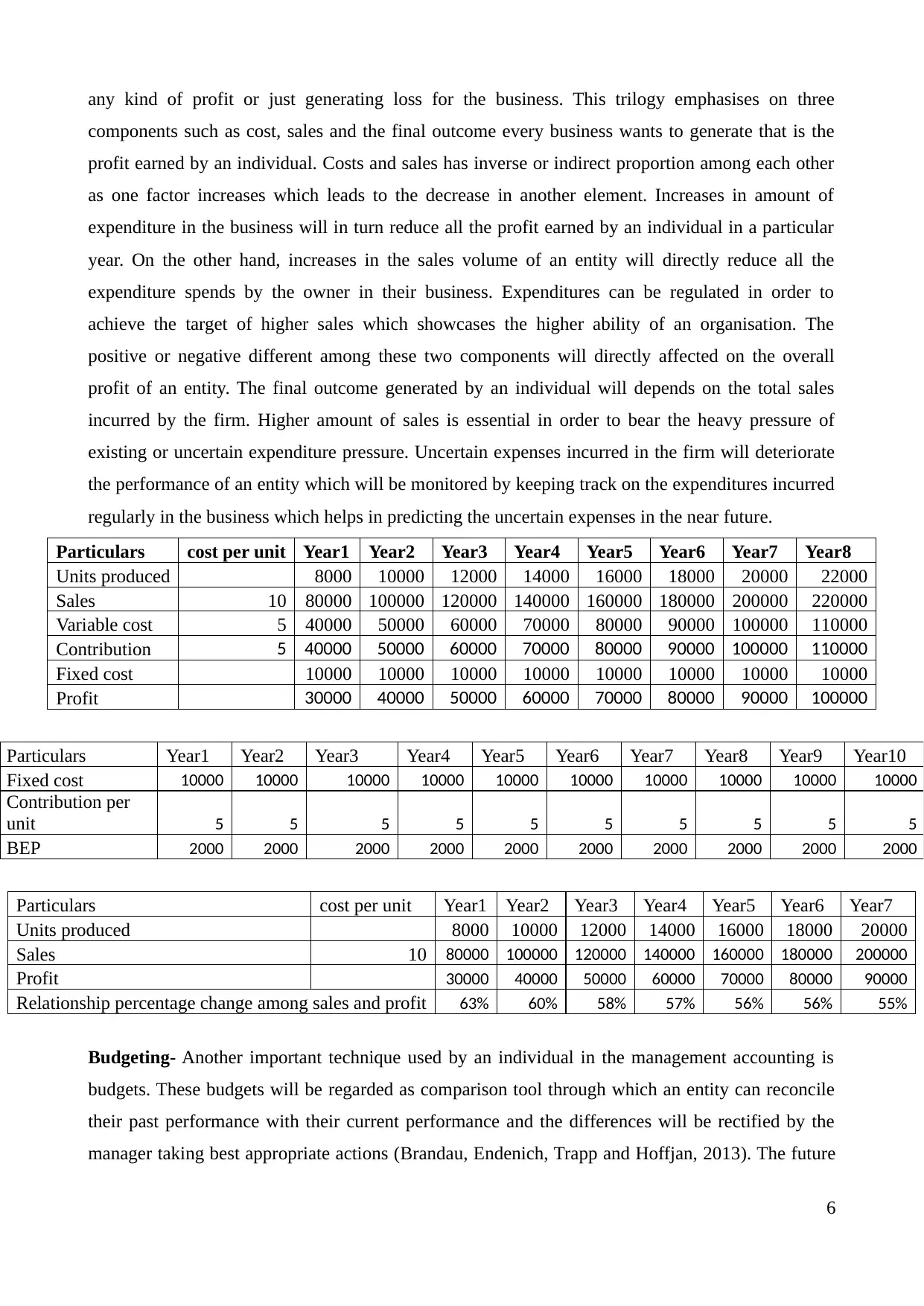
any kind of profit or just generating loss for the business. This trilogy emphasises on three
components such as cost, sales and the final outcome every business wants to generate that is the
profit earned by an individual. Costs and sales has inverse or indirect proportion among each other
as one factor increases which leads to the decrease in another element. Increases in amount of
expenditure in the business will in turn reduce all the profit earned by an individual in a particular
year. On the other hand, increases in the sales volume of an entity will directly reduce all the
expenditure spends by the owner in their business. Expenditures can be regulated in order to
achieve the target of higher sales which showcases the higher ability of an organisation. The
positive or negative different among these two components will directly affected on the overall
profit of an entity. The final outcome generated by an individual will depends on the total sales
incurred by the firm. Higher amount of sales is essential in order to bear the heavy pressure of
existing or uncertain expenditure pressure. Uncertain expenses incurred in the firm will deteriorate
the performance of an entity which will be monitored by keeping track on the expenditures incurred
regularly in the business which helps in predicting the uncertain expenses in the near future.
Particulars cost per unit Year1 Year2 Year3 Year4 Year5 Year6 Year7 Year8
Units produced 8000 10000 12000 14000 16000 18000 20000 22000
Sales 10 80000 100000 120000 140000 160000 180000 200000 220000
Variable cost 5 40000 50000 60000 70000 80000 90000 100000 110000
Contribution 5 40000 50000 60000 70000 80000 90000 100000 110000
Fixed cost 10000 10000 10000 10000 10000 10000 10000 10000
Profit 30000 40000 50000 60000 70000 80000 90000 100000
Particulars Year1 Year2 Year3 Year4 Year5 Year6 Year7 Year8 Year9 Year10
Fixed cost 10000 10000 10000 10000 10000 10000 10000 10000 10000 10000
Contribution per
unit 5 5 5 5 5 5 5 5 5 5
BEP 2000 2000 2000 2000 2000 2000 2000 2000 2000 2000
Particulars cost per unit Year1 Year2 Year3 Year4 Year5 Year6 Year7
Units produced 8000 10000 12000 14000 16000 18000 20000
Sales 10 80000 100000 120000 140000 160000 180000 200000
Profit 30000 40000 50000 60000 70000 80000 90000
Relationship percentage change among sales and profit 63% 60% 58% 57% 56% 56% 55%
Budgeting- Another important technique used by an individual in the management accounting is
budgets. These budgets will be regarded as comparison tool through which an entity can reconcile
their past performance with their current performance and the differences will be rectified by the
manager taking best appropriate actions (Brandau, Endenich, Trapp and Hoffjan, 2013). The future
6
components such as cost, sales and the final outcome every business wants to generate that is the
profit earned by an individual. Costs and sales has inverse or indirect proportion among each other
as one factor increases which leads to the decrease in another element. Increases in amount of
expenditure in the business will in turn reduce all the profit earned by an individual in a particular
year. On the other hand, increases in the sales volume of an entity will directly reduce all the
expenditure spends by the owner in their business. Expenditures can be regulated in order to
achieve the target of higher sales which showcases the higher ability of an organisation. The
positive or negative different among these two components will directly affected on the overall
profit of an entity. The final outcome generated by an individual will depends on the total sales
incurred by the firm. Higher amount of sales is essential in order to bear the heavy pressure of
existing or uncertain expenditure pressure. Uncertain expenses incurred in the firm will deteriorate
the performance of an entity which will be monitored by keeping track on the expenditures incurred
regularly in the business which helps in predicting the uncertain expenses in the near future.
Particulars cost per unit Year1 Year2 Year3 Year4 Year5 Year6 Year7 Year8
Units produced 8000 10000 12000 14000 16000 18000 20000 22000
Sales 10 80000 100000 120000 140000 160000 180000 200000 220000
Variable cost 5 40000 50000 60000 70000 80000 90000 100000 110000
Contribution 5 40000 50000 60000 70000 80000 90000 100000 110000
Fixed cost 10000 10000 10000 10000 10000 10000 10000 10000
Profit 30000 40000 50000 60000 70000 80000 90000 100000
Particulars Year1 Year2 Year3 Year4 Year5 Year6 Year7 Year8 Year9 Year10
Fixed cost 10000 10000 10000 10000 10000 10000 10000 10000 10000 10000
Contribution per
unit 5 5 5 5 5 5 5 5 5 5
BEP 2000 2000 2000 2000 2000 2000 2000 2000 2000 2000
Particulars cost per unit Year1 Year2 Year3 Year4 Year5 Year6 Year7
Units produced 8000 10000 12000 14000 16000 18000 20000
Sales 10 80000 100000 120000 140000 160000 180000 200000
Profit 30000 40000 50000 60000 70000 80000 90000
Relationship percentage change among sales and profit 63% 60% 58% 57% 56% 56% 55%
Budgeting- Another important technique used by an individual in the management accounting is
budgets. These budgets will be regarded as comparison tool through which an entity can reconcile
their past performance with their current performance and the differences will be rectified by the
manager taking best appropriate actions (Brandau, Endenich, Trapp and Hoffjan, 2013). The future
6
⊘ This is a preview!⊘
Do you want full access?
Subscribe today to unlock all pages.

Trusted by 1+ million students worldwide
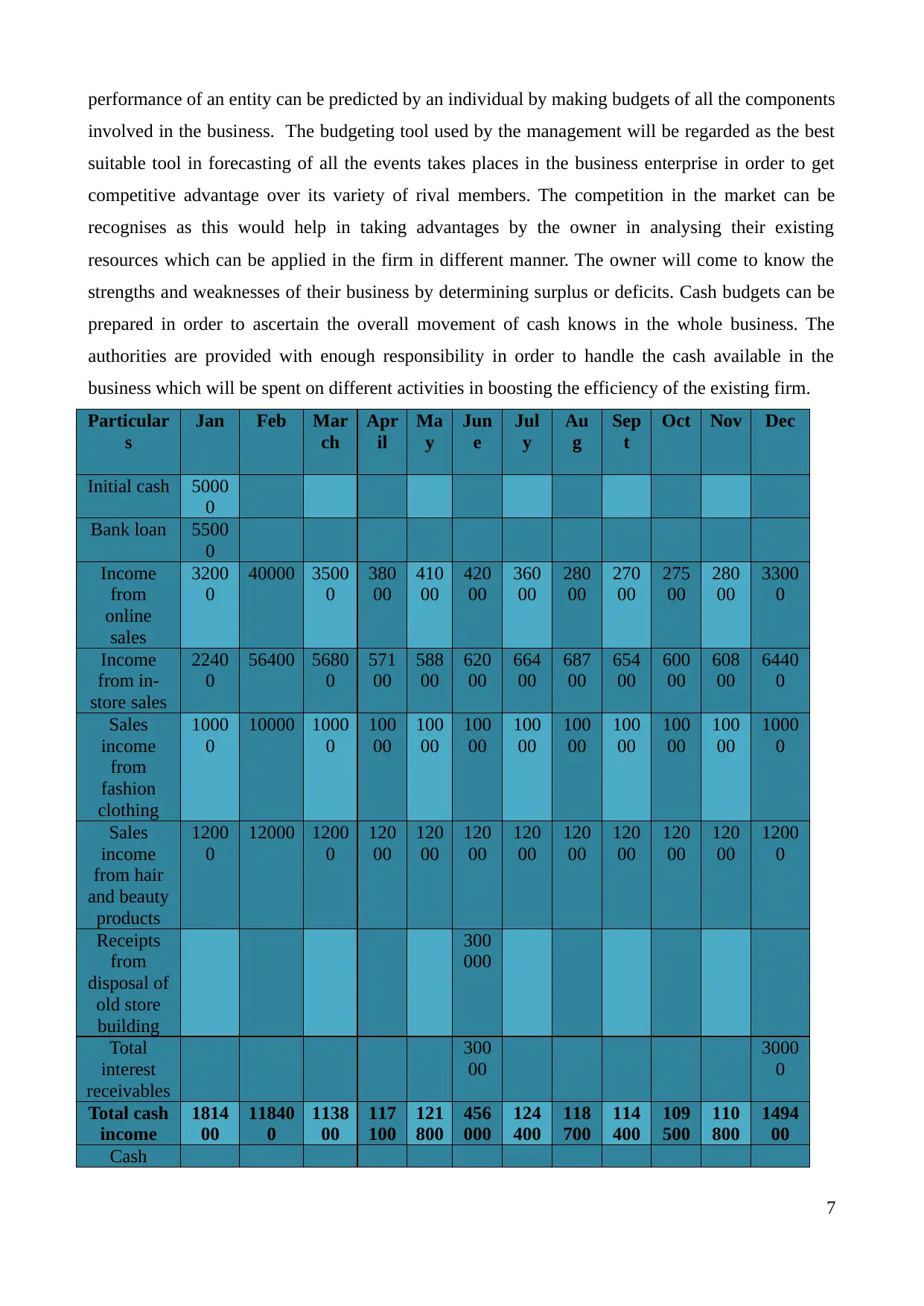
performance of an entity can be predicted by an individual by making budgets of all the components
involved in the business. The budgeting tool used by the management will be regarded as the best
suitable tool in forecasting of all the events takes places in the business enterprise in order to get
competitive advantage over its variety of rival members. The competition in the market can be
recognises as this would help in taking advantages by the owner in analysing their existing
resources which can be applied in the firm in different manner. The owner will come to know the
strengths and weaknesses of their business by determining surplus or deficits. Cash budgets can be
prepared in order to ascertain the overall movement of cash knows in the whole business. The
authorities are provided with enough responsibility in order to handle the cash available in the
business which will be spent on different activities in boosting the efficiency of the existing firm.
Particular
s
Jan Feb Mar
ch
Apr
il
Ma
y
Jun
e
Jul
y
Au
g
Sep
t
Oct Nov Dec
Initial cash 5000
0
Bank loan 5500
0
Income
from
online
sales
3200
0
40000 3500
0
380
00
410
00
420
00
360
00
280
00
270
00
275
00
280
00
3300
0
Income
from in-
store sales
2240
0
56400 5680
0
571
00
588
00
620
00
664
00
687
00
654
00
600
00
608
00
6440
0
Sales
income
from
fashion
clothing
1000
0
10000 1000
0
100
00
100
00
100
00
100
00
100
00
100
00
100
00
100
00
1000
0
Sales
income
from hair
and beauty
products
1200
0
12000 1200
0
120
00
120
00
120
00
120
00
120
00
120
00
120
00
120
00
1200
0
Receipts
from
disposal of
old store
building
300
000
Total
interest
receivables
300
00
3000
0
Total cash
income
1814
00
11840
0
1138
00
117
100
121
800
456
000
124
400
118
700
114
400
109
500
110
800
1494
00
Cash
7
involved in the business. The budgeting tool used by the management will be regarded as the best
suitable tool in forecasting of all the events takes places in the business enterprise in order to get
competitive advantage over its variety of rival members. The competition in the market can be
recognises as this would help in taking advantages by the owner in analysing their existing
resources which can be applied in the firm in different manner. The owner will come to know the
strengths and weaknesses of their business by determining surplus or deficits. Cash budgets can be
prepared in order to ascertain the overall movement of cash knows in the whole business. The
authorities are provided with enough responsibility in order to handle the cash available in the
business which will be spent on different activities in boosting the efficiency of the existing firm.
Particular
s
Jan Feb Mar
ch
Apr
il
Ma
y
Jun
e
Jul
y
Au
g
Sep
t
Oct Nov Dec
Initial cash 5000
0
Bank loan 5500
0
Income
from
online
sales
3200
0
40000 3500
0
380
00
410
00
420
00
360
00
280
00
270
00
275
00
280
00
3300
0
Income
from in-
store sales
2240
0
56400 5680
0
571
00
588
00
620
00
664
00
687
00
654
00
600
00
608
00
6440
0
Sales
income
from
fashion
clothing
1000
0
10000 1000
0
100
00
100
00
100
00
100
00
100
00
100
00
100
00
100
00
1000
0
Sales
income
from hair
and beauty
products
1200
0
12000 1200
0
120
00
120
00
120
00
120
00
120
00
120
00
120
00
120
00
1200
0
Receipts
from
disposal of
old store
building
300
000
Total
interest
receivables
300
00
3000
0
Total cash
income
1814
00
11840
0
1138
00
117
100
121
800
456
000
124
400
118
700
114
400
109
500
110
800
1494
00
Cash
7
Paraphrase This Document
Need a fresh take? Get an instant paraphrase of this document with our AI Paraphraser
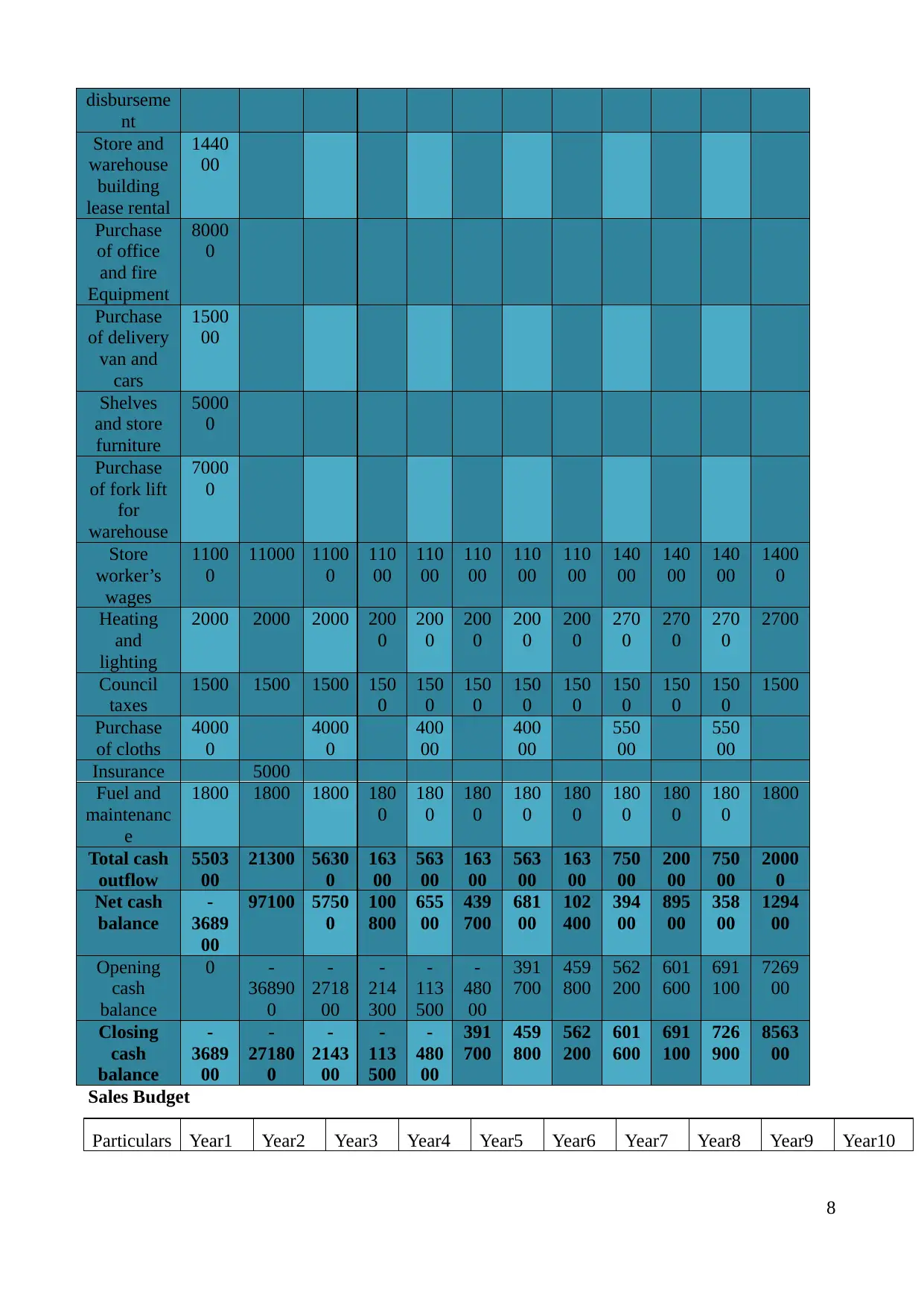
disburseme
nt
Store and
warehouse
building
lease rental
1440
00
Purchase
of office
and fire
Equipment
8000
0
Purchase
of delivery
van and
cars
1500
00
Shelves
and store
furniture
5000
0
Purchase
of fork lift
for
warehouse
7000
0
Store
worker’s
wages
1100
0
11000 1100
0
110
00
110
00
110
00
110
00
110
00
140
00
140
00
140
00
1400
0
Heating
and
lighting
2000 2000 2000 200
0
200
0
200
0
200
0
200
0
270
0
270
0
270
0
2700
Council
taxes
1500 1500 1500 150
0
150
0
150
0
150
0
150
0
150
0
150
0
150
0
1500
Purchase
of cloths
4000
0
4000
0
400
00
400
00
550
00
550
00
Insurance 5000
Fuel and
maintenanc
e
1800 1800 1800 180
0
180
0
180
0
180
0
180
0
180
0
180
0
180
0
1800
Total cash
outflow
5503
00
21300 5630
0
163
00
563
00
163
00
563
00
163
00
750
00
200
00
750
00
2000
0
Net cash
balance
-
3689
00
97100 5750
0
100
800
655
00
439
700
681
00
102
400
394
00
895
00
358
00
1294
00
Opening
cash
balance
0 -
36890
0
-
2718
00
-
214
300
-
113
500
-
480
00
391
700
459
800
562
200
601
600
691
100
7269
00
Closing
cash
balance
-
3689
00
-
27180
0
-
2143
00
-
113
500
-
480
00
391
700
459
800
562
200
601
600
691
100
726
900
8563
00
Sales Budget
Particulars Year1 Year2 Year3 Year4 Year5 Year6 Year7 Year8 Year9 Year10
8
nt
Store and
warehouse
building
lease rental
1440
00
Purchase
of office
and fire
Equipment
8000
0
Purchase
of delivery
van and
cars
1500
00
Shelves
and store
furniture
5000
0
Purchase
of fork lift
for
warehouse
7000
0
Store
worker’s
wages
1100
0
11000 1100
0
110
00
110
00
110
00
110
00
110
00
140
00
140
00
140
00
1400
0
Heating
and
lighting
2000 2000 2000 200
0
200
0
200
0
200
0
200
0
270
0
270
0
270
0
2700
Council
taxes
1500 1500 1500 150
0
150
0
150
0
150
0
150
0
150
0
150
0
150
0
1500
Purchase
of cloths
4000
0
4000
0
400
00
400
00
550
00
550
00
Insurance 5000
Fuel and
maintenanc
e
1800 1800 1800 180
0
180
0
180
0
180
0
180
0
180
0
180
0
180
0
1800
Total cash
outflow
5503
00
21300 5630
0
163
00
563
00
163
00
563
00
163
00
750
00
200
00
750
00
2000
0
Net cash
balance
-
3689
00
97100 5750
0
100
800
655
00
439
700
681
00
102
400
394
00
895
00
358
00
1294
00
Opening
cash
balance
0 -
36890
0
-
2718
00
-
214
300
-
113
500
-
480
00
391
700
459
800
562
200
601
600
691
100
7269
00
Closing
cash
balance
-
3689
00
-
27180
0
-
2143
00
-
113
500
-
480
00
391
700
459
800
562
200
601
600
691
100
726
900
8563
00
Sales Budget
Particulars Year1 Year2 Year3 Year4 Year5 Year6 Year7 Year8 Year9 Year10
8
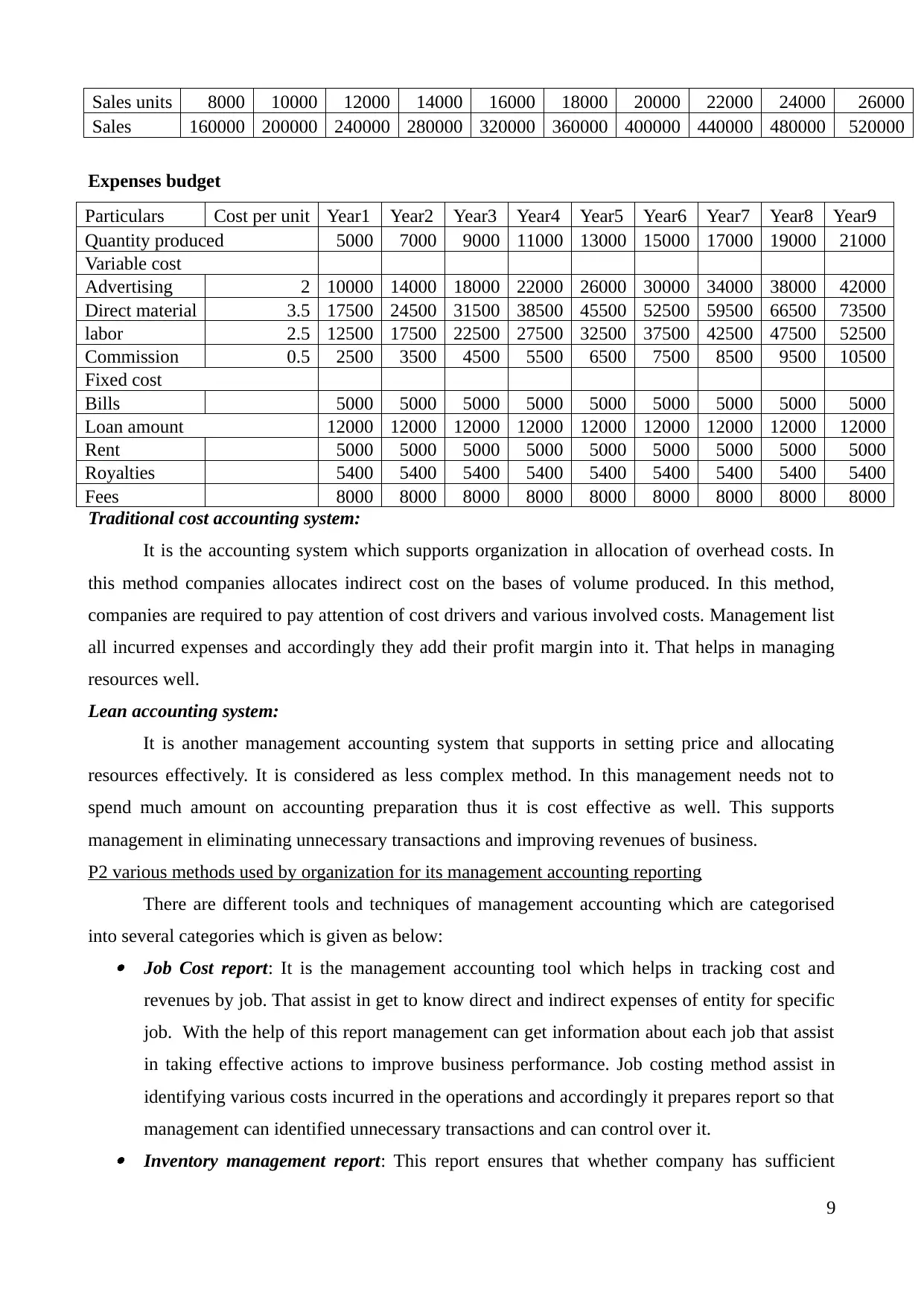
Sales units 8000 10000 12000 14000 16000 18000 20000 22000 24000 26000
Sales 160000 200000 240000 280000 320000 360000 400000 440000 480000 520000
Expenses budget
Particulars Cost per unit Year1 Year2 Year3 Year4 Year5 Year6 Year7 Year8 Year9
Quantity produced 5000 7000 9000 11000 13000 15000 17000 19000 21000
Variable cost
Advertising 2 10000 14000 18000 22000 26000 30000 34000 38000 42000
Direct material 3.5 17500 24500 31500 38500 45500 52500 59500 66500 73500
labor 2.5 12500 17500 22500 27500 32500 37500 42500 47500 52500
Commission 0.5 2500 3500 4500 5500 6500 7500 8500 9500 10500
Fixed cost
Bills 5000 5000 5000 5000 5000 5000 5000 5000 5000
Loan amount 12000 12000 12000 12000 12000 12000 12000 12000 12000
Rent 5000 5000 5000 5000 5000 5000 5000 5000 5000
Royalties 5400 5400 5400 5400 5400 5400 5400 5400 5400
Fees 8000 8000 8000 8000 8000 8000 8000 8000 8000
Traditional cost accounting system:
It is the accounting system which supports organization in allocation of overhead costs. In
this method companies allocates indirect cost on the bases of volume produced. In this method,
companies are required to pay attention of cost drivers and various involved costs. Management list
all incurred expenses and accordingly they add their profit margin into it. That helps in managing
resources well.
Lean accounting system:
It is another management accounting system that supports in setting price and allocating
resources effectively. It is considered as less complex method. In this management needs not to
spend much amount on accounting preparation thus it is cost effective as well. This supports
management in eliminating unnecessary transactions and improving revenues of business.
P2 various methods used by organization for its management accounting reporting
There are different tools and techniques of management accounting which are categorised
into several categories which is given as below: Job Cost report: It is the management accounting tool which helps in tracking cost and
revenues by job. That assist in get to know direct and indirect expenses of entity for specific
job. With the help of this report management can get information about each job that assist
in taking effective actions to improve business performance. Job costing method assist in
identifying various costs incurred in the operations and accordingly it prepares report so that
management can identified unnecessary transactions and can control over it. Inventory management report: This report ensures that whether company has sufficient
9
Sales 160000 200000 240000 280000 320000 360000 400000 440000 480000 520000
Expenses budget
Particulars Cost per unit Year1 Year2 Year3 Year4 Year5 Year6 Year7 Year8 Year9
Quantity produced 5000 7000 9000 11000 13000 15000 17000 19000 21000
Variable cost
Advertising 2 10000 14000 18000 22000 26000 30000 34000 38000 42000
Direct material 3.5 17500 24500 31500 38500 45500 52500 59500 66500 73500
labor 2.5 12500 17500 22500 27500 32500 37500 42500 47500 52500
Commission 0.5 2500 3500 4500 5500 6500 7500 8500 9500 10500
Fixed cost
Bills 5000 5000 5000 5000 5000 5000 5000 5000 5000
Loan amount 12000 12000 12000 12000 12000 12000 12000 12000 12000
Rent 5000 5000 5000 5000 5000 5000 5000 5000 5000
Royalties 5400 5400 5400 5400 5400 5400 5400 5400 5400
Fees 8000 8000 8000 8000 8000 8000 8000 8000 8000
Traditional cost accounting system:
It is the accounting system which supports organization in allocation of overhead costs. In
this method companies allocates indirect cost on the bases of volume produced. In this method,
companies are required to pay attention of cost drivers and various involved costs. Management list
all incurred expenses and accordingly they add their profit margin into it. That helps in managing
resources well.
Lean accounting system:
It is another management accounting system that supports in setting price and allocating
resources effectively. It is considered as less complex method. In this management needs not to
spend much amount on accounting preparation thus it is cost effective as well. This supports
management in eliminating unnecessary transactions and improving revenues of business.
P2 various methods used by organization for its management accounting reporting
There are different tools and techniques of management accounting which are categorised
into several categories which is given as below: Job Cost report: It is the management accounting tool which helps in tracking cost and
revenues by job. That assist in get to know direct and indirect expenses of entity for specific
job. With the help of this report management can get information about each job that assist
in taking effective actions to improve business performance. Job costing method assist in
identifying various costs incurred in the operations and accordingly it prepares report so that
management can identified unnecessary transactions and can control over it. Inventory management report: This report ensures that whether company has sufficient
9
⊘ This is a preview!⊘
Do you want full access?
Subscribe today to unlock all pages.

Trusted by 1+ million students worldwide
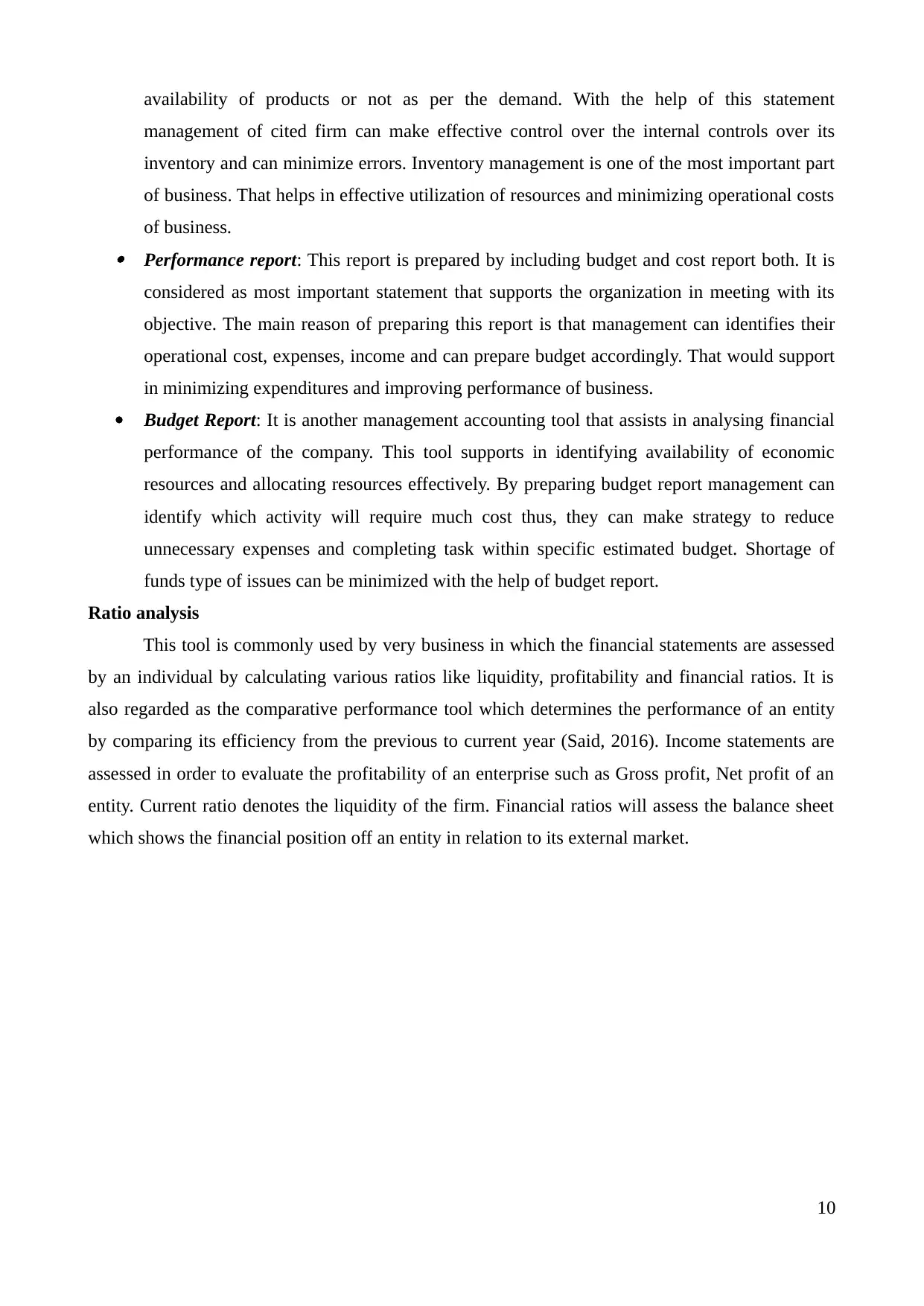
availability of products or not as per the demand. With the help of this statement
management of cited firm can make effective control over the internal controls over its
inventory and can minimize errors. Inventory management is one of the most important part
of business. That helps in effective utilization of resources and minimizing operational costs
of business. Performance report: This report is prepared by including budget and cost report both. It is
considered as most important statement that supports the organization in meeting with its
objective. The main reason of preparing this report is that management can identifies their
operational cost, expenses, income and can prepare budget accordingly. That would support
in minimizing expenditures and improving performance of business.
Budget Report: It is another management accounting tool that assists in analysing financial
performance of the company. This tool supports in identifying availability of economic
resources and allocating resources effectively. By preparing budget report management can
identify which activity will require much cost thus, they can make strategy to reduce
unnecessary expenses and completing task within specific estimated budget. Shortage of
funds type of issues can be minimized with the help of budget report.
Ratio analysis
This tool is commonly used by very business in which the financial statements are assessed
by an individual by calculating various ratios like liquidity, profitability and financial ratios. It is
also regarded as the comparative performance tool which determines the performance of an entity
by comparing its efficiency from the previous to current year (Said, 2016). Income statements are
assessed in order to evaluate the profitability of an enterprise such as Gross profit, Net profit of an
entity. Current ratio denotes the liquidity of the firm. Financial ratios will assess the balance sheet
which shows the financial position off an entity in relation to its external market.
10
management of cited firm can make effective control over the internal controls over its
inventory and can minimize errors. Inventory management is one of the most important part
of business. That helps in effective utilization of resources and minimizing operational costs
of business. Performance report: This report is prepared by including budget and cost report both. It is
considered as most important statement that supports the organization in meeting with its
objective. The main reason of preparing this report is that management can identifies their
operational cost, expenses, income and can prepare budget accordingly. That would support
in minimizing expenditures and improving performance of business.
Budget Report: It is another management accounting tool that assists in analysing financial
performance of the company. This tool supports in identifying availability of economic
resources and allocating resources effectively. By preparing budget report management can
identify which activity will require much cost thus, they can make strategy to reduce
unnecessary expenses and completing task within specific estimated budget. Shortage of
funds type of issues can be minimized with the help of budget report.
Ratio analysis
This tool is commonly used by very business in which the financial statements are assessed
by an individual by calculating various ratios like liquidity, profitability and financial ratios. It is
also regarded as the comparative performance tool which determines the performance of an entity
by comparing its efficiency from the previous to current year (Said, 2016). Income statements are
assessed in order to evaluate the profitability of an enterprise such as Gross profit, Net profit of an
entity. Current ratio denotes the liquidity of the firm. Financial ratios will assess the balance sheet
which shows the financial position off an entity in relation to its external market.
10
Paraphrase This Document
Need a fresh take? Get an instant paraphrase of this document with our AI Paraphraser
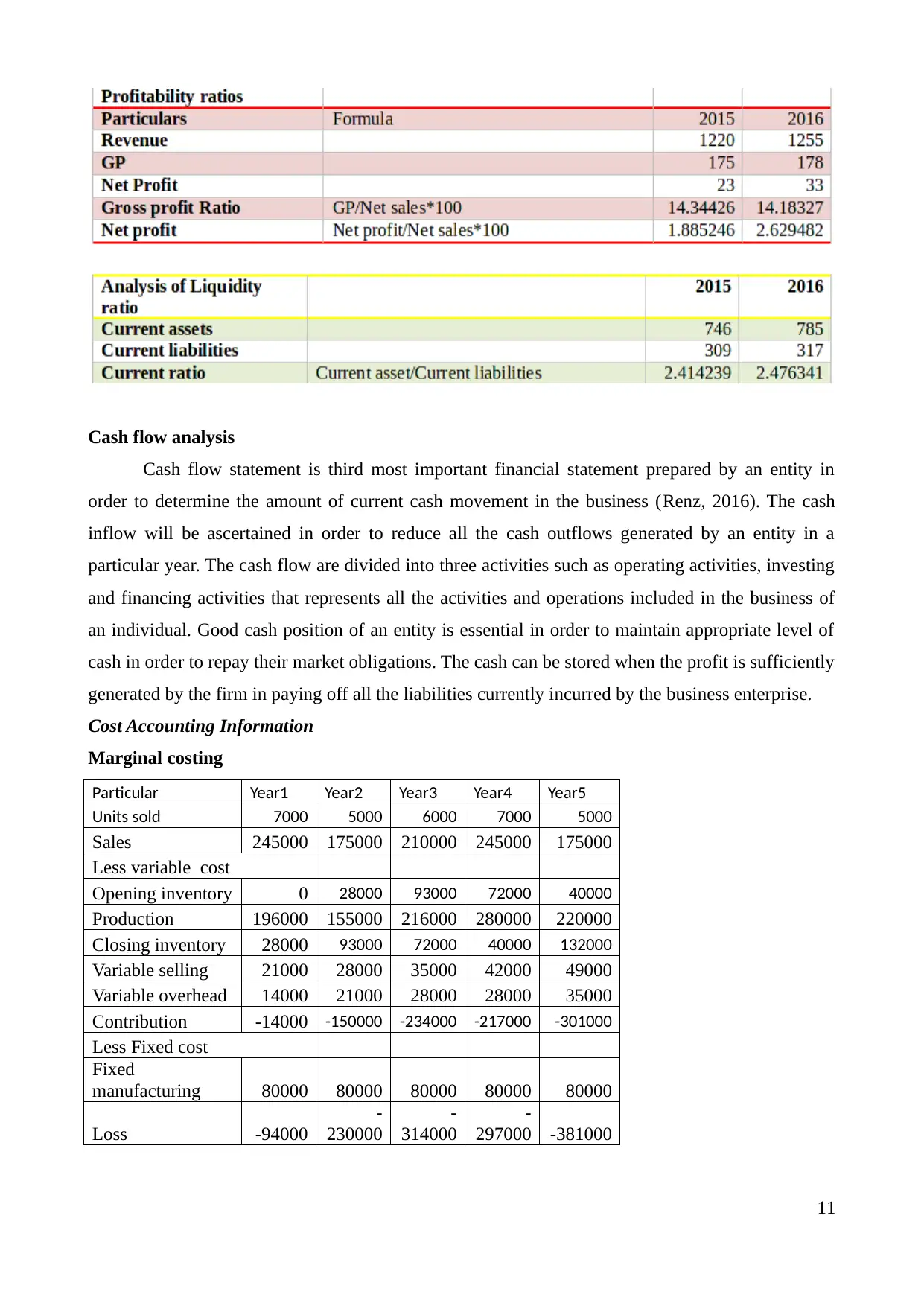
Cash flow analysis
Cash flow statement is third most important financial statement prepared by an entity in
order to determine the amount of current cash movement in the business (Renz, 2016). The cash
inflow will be ascertained in order to reduce all the cash outflows generated by an entity in a
particular year. The cash flow are divided into three activities such as operating activities, investing
and financing activities that represents all the activities and operations included in the business of
an individual. Good cash position of an entity is essential in order to maintain appropriate level of
cash in order to repay their market obligations. The cash can be stored when the profit is sufficiently
generated by the firm in paying off all the liabilities currently incurred by the business enterprise.
Cost Accounting Information
Marginal costing
Particular Year1 Year2 Year3 Year4 Year5
Units sold 7000 5000 6000 7000 5000
Sales 245000 175000 210000 245000 175000
Less variable cost
Opening inventory 0 28000 93000 72000 40000
Production 196000 155000 216000 280000 220000
Closing inventory 28000 93000 72000 40000 132000
Variable selling 21000 28000 35000 42000 49000
Variable overhead 14000 21000 28000 28000 35000
Contribution -14000 -150000 -234000 -217000 -301000
Less Fixed cost
Fixed
manufacturing 80000 80000 80000 80000 80000
Loss -94000
-
230000
-
314000
-
297000 -381000
11
Cash flow statement is third most important financial statement prepared by an entity in
order to determine the amount of current cash movement in the business (Renz, 2016). The cash
inflow will be ascertained in order to reduce all the cash outflows generated by an entity in a
particular year. The cash flow are divided into three activities such as operating activities, investing
and financing activities that represents all the activities and operations included in the business of
an individual. Good cash position of an entity is essential in order to maintain appropriate level of
cash in order to repay their market obligations. The cash can be stored when the profit is sufficiently
generated by the firm in paying off all the liabilities currently incurred by the business enterprise.
Cost Accounting Information
Marginal costing
Particular Year1 Year2 Year3 Year4 Year5
Units sold 7000 5000 6000 7000 5000
Sales 245000 175000 210000 245000 175000
Less variable cost
Opening inventory 0 28000 93000 72000 40000
Production 196000 155000 216000 280000 220000
Closing inventory 28000 93000 72000 40000 132000
Variable selling 21000 28000 35000 42000 49000
Variable overhead 14000 21000 28000 28000 35000
Contribution -14000 -150000 -234000 -217000 -301000
Less Fixed cost
Fixed
manufacturing 80000 80000 80000 80000 80000
Loss -94000
-
230000
-
314000
-
297000 -381000
11
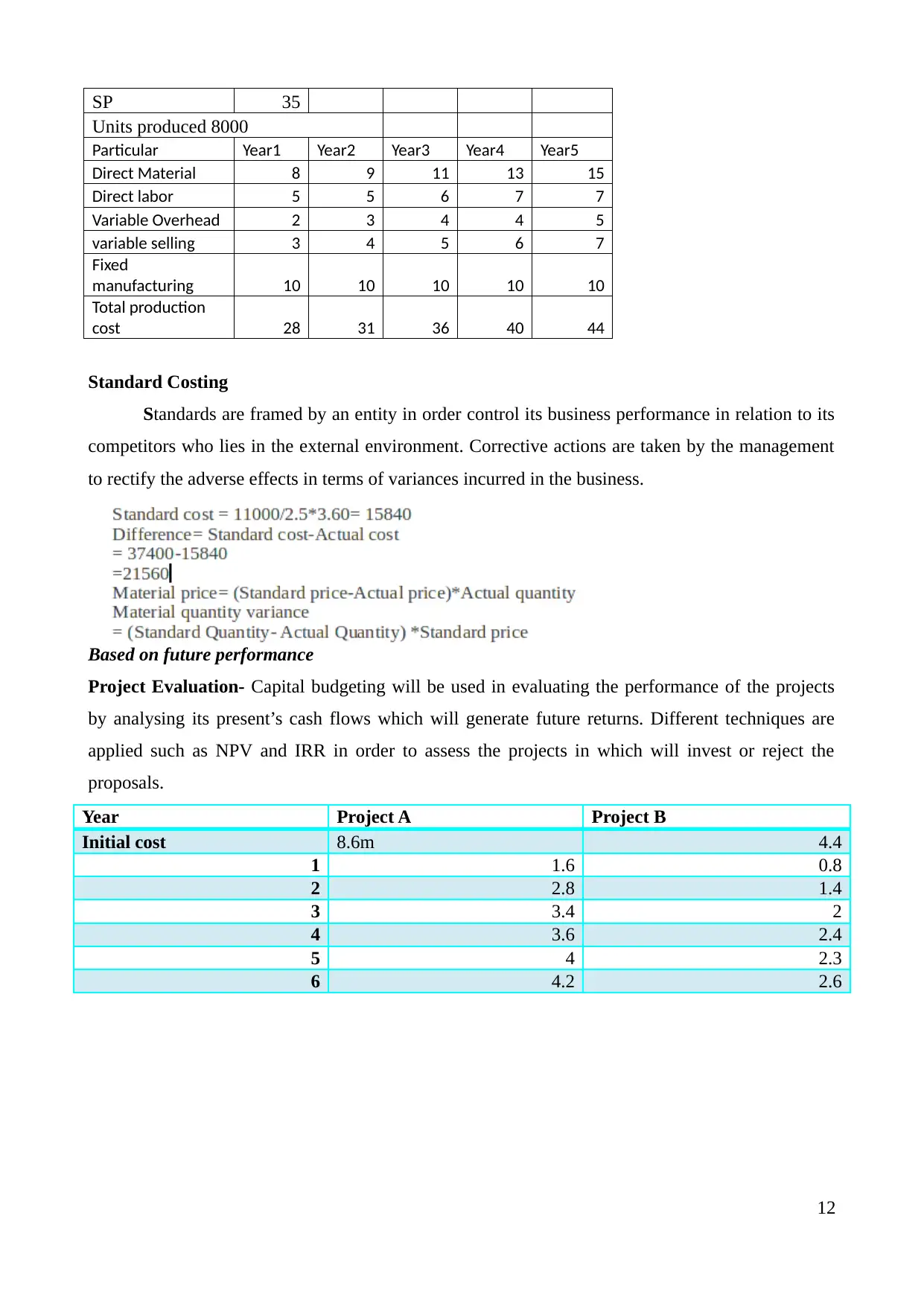
SP 35
Units produced 8000
Particular Year1 Year2 Year3 Year4 Year5
Direct Material 8 9 11 13 15
Direct labor 5 5 6 7 7
Variable Overhead 2 3 4 4 5
variable selling 3 4 5 6 7
Fixed
manufacturing 10 10 10 10 10
Total production
cost 28 31 36 40 44
Standard Costing
Standards are framed by an entity in order control its business performance in relation to its
competitors who lies in the external environment. Corrective actions are taken by the management
to rectify the adverse effects in terms of variances incurred in the business.
Based on future performance
Project Evaluation- Capital budgeting will be used in evaluating the performance of the projects
by analysing its present’s cash flows which will generate future returns. Different techniques are
applied such as NPV and IRR in order to assess the projects in which will invest or reject the
proposals.
Year Project A Project B
Initial cost 8.6m 4.4
1 1.6 0.8
2 2.8 1.4
3 3.4 2
4 3.6 2.4
5 4 2.3
6 4.2 2.6
12
Units produced 8000
Particular Year1 Year2 Year3 Year4 Year5
Direct Material 8 9 11 13 15
Direct labor 5 5 6 7 7
Variable Overhead 2 3 4 4 5
variable selling 3 4 5 6 7
Fixed
manufacturing 10 10 10 10 10
Total production
cost 28 31 36 40 44
Standard Costing
Standards are framed by an entity in order control its business performance in relation to its
competitors who lies in the external environment. Corrective actions are taken by the management
to rectify the adverse effects in terms of variances incurred in the business.
Based on future performance
Project Evaluation- Capital budgeting will be used in evaluating the performance of the projects
by analysing its present’s cash flows which will generate future returns. Different techniques are
applied such as NPV and IRR in order to assess the projects in which will invest or reject the
proposals.
Year Project A Project B
Initial cost 8.6m 4.4
1 1.6 0.8
2 2.8 1.4
3 3.4 2
4 3.6 2.4
5 4 2.3
6 4.2 2.6
12
⊘ This is a preview!⊘
Do you want full access?
Subscribe today to unlock all pages.

Trusted by 1+ million students worldwide
1 out of 23
Related Documents
Your All-in-One AI-Powered Toolkit for Academic Success.
+13062052269
info@desklib.com
Available 24*7 on WhatsApp / Email
![[object Object]](/_next/static/media/star-bottom.7253800d.svg)
Unlock your academic potential
Copyright © 2020–2025 A2Z Services. All Rights Reserved. Developed and managed by ZUCOL.




